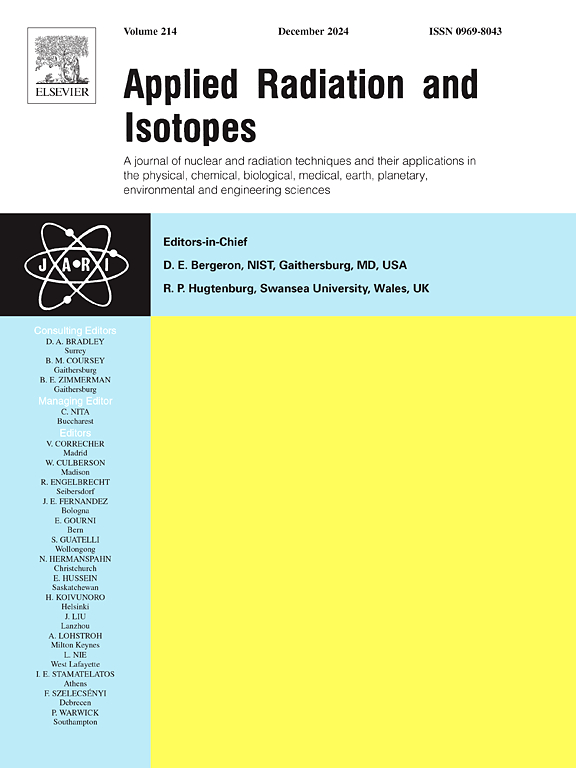First pilot tests of Compton imaging and boron concentration measurements in BNCT using i-TED
IF 1.6
3区 工程技术
Q3 CHEMISTRY, INORGANIC & NUCLEAR
引用次数: 0
Abstract
Dosimetry in BNCT poses significant challenges due to the indirect effect of neutrons interacting with elements within the body and uncertainties associated with the uptake of boron compounds used in clinical practice. Current treatment planning relies on unconventional estimates of boron tumor uptake derived from prior PET scans and thus, an online boron-uptake monitor would be highly convenient. This work presents the first pilot experiments carried out at ILL-Grenoble with the high-efficiency Compton camera i-TED, hereby aiming at demonstrating its applicability for BNCT dosimetry by introducing real-time measurement of the boron concentration and imaging capabilities of spatial dose distribution. In this experiment, we measured the 10B uptake of different cancer cells of tongue squamous cell carcinoma, malignant melanoma and glioblastoma treated with BPA (80 ppm of 10B). The samples were irradiated with the thermal neutron spectrum of ILL-Grenoble and the 478 keV -rays from the 7Li de-excitation after the neutron-boron reaction were registered both with the Compton imager and the high-sensitivity FIPPS HPGe array. These series of measurements allowed us to demonstrate the imaging capabilities of the Compton imaging device for the 478 keV -rays of interest for dosimetry in BNCT, as well as to assess its sensitivity, which was found to be below of 10B.
首次试点测试康普顿成像和硼浓度测量在BNCT使用i-TED
由于中子与体内元素相互作用的间接影响以及临床实践中使用的硼化合物吸收的不确定性,BNCT的剂量测定面临重大挑战。目前的治疗计划依赖于先前PET扫描得出的硼肿瘤摄取的非常规估计,因此,在线硼摄取监测仪将非常方便。本文首次利用i-TED高效康普顿相机在ILL-Grenoble进行了先导实验,旨在通过引入硼浓度的实时测量和空间剂量分布的成像能力,证明其在BNCT剂量学中的适用性。在本实验中,我们测量了双酚a (80 ppm的10B)对舌鳞状细胞癌、恶性黑色素瘤和胶质母细胞瘤不同癌细胞的10B摄取。用康普顿成像仪和高灵敏度FIPPS HPGe阵列记录中子-硼反应后,用il - grenoble热中子谱和7Li退激发产生的478 keV γ射线照射样品。这一系列的测量使我们能够证明康普顿成像设备对BNCT剂量学中感兴趣的478 keV γ射线的成像能力,以及评估其灵敏度,发现其灵敏度低于1μg的10B。
本文章由计算机程序翻译,如有差异,请以英文原文为准。
求助全文
约1分钟内获得全文
求助全文
来源期刊

Applied Radiation and Isotopes
工程技术-核科学技术
CiteScore
3.00
自引率
12.50%
发文量
406
审稿时长
13.5 months
期刊介绍:
Applied Radiation and Isotopes provides a high quality medium for the publication of substantial, original and scientific and technological papers on the development and peaceful application of nuclear, radiation and radionuclide techniques in chemistry, physics, biochemistry, biology, medicine, security, engineering and in the earth, planetary and environmental sciences, all including dosimetry. Nuclear techniques are defined in the broadest sense and both experimental and theoretical papers are welcome. They include the development and use of α- and β-particles, X-rays and γ-rays, neutrons and other nuclear particles and radiations from all sources, including radionuclides, synchrotron sources, cyclotrons and reactors and from the natural environment.
The journal aims to publish papers with significance to an international audience, containing substantial novelty and scientific impact. The Editors reserve the rights to reject, with or without external review, papers that do not meet these criteria.
Papers dealing with radiation processing, i.e., where radiation is used to bring about a biological, chemical or physical change in a material, should be directed to our sister journal Radiation Physics and Chemistry.
 求助内容:
求助内容: 应助结果提醒方式:
应助结果提醒方式:


